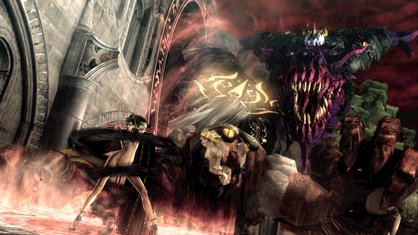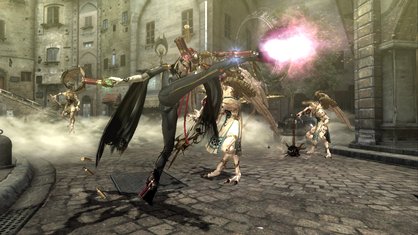The fighting system is simple, says Kamiya, but with almost limitless potential. Bayonetta’s got guns in her hands and guns on her feet – obviously – but to compound that you pick up further weapons throughout the game. “The basic configuration will be enough to get you through if you’re good enough, though each weapon should have enough merits and demerits that everyone will appreciate the variety. There should be infinite scope in all these different weapon combos, especially when considering which situation to use them in, second by second, deciding which weapons go to hands and which to feet.”
This, says producer Yusuke Hashimoto, will take Bayonetta’s tactical breadth beyond even that of DMC3 and 4. Able to create different configurations of gun and sword both before each battle and while the game is paused, you can then juggle them on the fly. “Maybe your ‘A’ set will be heavy weapons in the hands and handguns on the feet,” he suggests, “while your ‘B’ set might be swords in the hands and shotguns on the feet. And then you swap weapons out during combos: a punch with the gun, perhaps, a kick with the shotgun, then a switch to the katana.”

So is this a game that anyone can play, or just the DMC hardcore? “Well, we’re trying to pull in action fans generally, and that crowd will naturally include the DMC fans,” says Hashimoto. DMC4, we remind them, used questionable adaptive difficulty, not to mention a character (Nero) to make the game easier. Kamiya scowls. “In a game like Bayonetta, the idea is that you rise to the game’s challenge as you fight your way through it,” he says. “If the difficulty drops to help you get on, that isn’t really any fun. It might be appropriate for various styles of games, but it’s something we absolutely don’t want in ours.”

“Especially when it’s so obvious,” adds Hashimoto. “If you’re having problems, just start the game over and set it to Easy.” The next level shown, The Angel’s Metropolis, leaves us with little doubt of what a Bayonetta boss battle entails. Once upon a time, Capcom games such as Forgotten Worlds had the old school marveling at “enemies the size of the screen!” Now hold that thought. Having pulverized her way through a magnificent cathedral city – the classic DMC backdrop, it must be said – Bayonetta’s reached a bridge when it appears: an angelic titan to rival anything in, well, anything. The movement between set pieces is quick, the fight crashing between Earth and sky, each exchange an opportunity to rack up combo points.

The bridge, we assume, will be the cornerstone of the battle, a platform from which to mount attacks and defend against the giant’s sweeping limbs. Then he grabs it, breaks off a chunk beneath Bayonetta’s feet, and hurls it across the level into a wall – while she’s still on it. He does what? Just what we were thinking. As she leaps free of the rubble, he charges in and the fight resumes. The hair dragon is summoned for the eventual coup de grâce, devouring its prey through frantic button-mashing. A helluva way to close out a level, we remark. “That’s the mid-level boss,” grins Kamiya.
So it goes for the rest of the game. Unlike Dante, Bayonetta doesn’t so much quest as ricochet through her game, bouncing from one epic clash to another. You can either marvel at this or seek to perfect it, choosing the right moves to score the highest points, dodging the strikes that would cut the combos short. If you want to stop for breath, there’s a backstory about her rebirth that Platinum’s keeping close to its chest. The usual nonsense, probably, but this time involving a bombshell of a character, delicious kills, and some particularly daring camera angles. We can’t help but notice one animator tweaking a shot that starts with a spread pair of legs and ends… well, best leave some things to the imagination, eh?
Nov 21, 2008
Weekly digests, tales from the communities you love, and more


